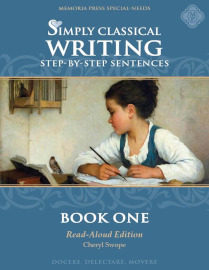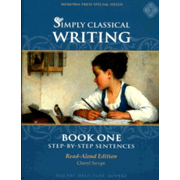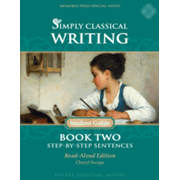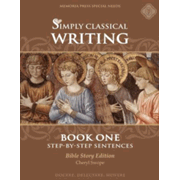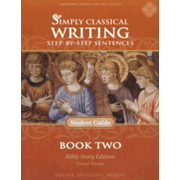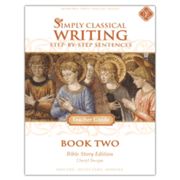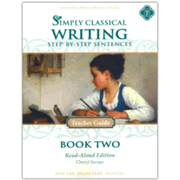Simply Classical Writing, Step-By-Step Sentences is a series for teaching beginning writing skills and grammar to children with learning difficulties. There are two levels thus far and two options for each level: the Read-Aloud Edition and the Bible Story Edition. Book One is for ages six through eight, and Book Two is for ages eight through eleven (or children working at those skill levels). Book One and Book Two are used with levels two and three of Memoria Press’s Simply Classical curriculum packages.
The two versions of Book One and Book Two teach the same skills but they use different reading material and different practice material for copywork, writing, and other exercises.
The Book One editions do not require a teacher guide, but lesson plans that cover either edition are included within Simply Classical Level 2 Bible & Copywork II Lesson Plans or in the Simply Classical Curriculum Manual: Level 2. Both Book Two editions have separate teacher guides that you need.
The Read-Aloud Editions incorporate a sizable number of children’s picture books (27 for Book One and 29 for Book Two) to link writing with listening and reading skills. The Book One: Read-Aloud edition uses an assortment of books and stories with no central theme—books such as Stellaluna, Katy and the Big Snow, and A Children’s Anthology of Poems & Lullabies, as well as recorded stories on the Animal Tales CD by Jim Weiss. The Book Two: Read-Aloud Edition uses books about famous people and events from American history, such as Meet George Washington by Joan Heilbroner and Riding the Pony Express by Clyde Robert Bulla.
Similarly, the Bible Story Editions use A Child’s Garden of Bible Stories with Book One and The Story Bible (Concordia Publishing House) with Book Two.
You can purchase the books used along with each course from Memoria Press. However, the Teacher Notes for the Read-Aloud courses say that the specified books can be borrowed from the library but are not absolutely required for the Read-Aloud Editions and that other sources for Bible stories may be used with the Bible Editions.
Each course has 34 lessons. Each lesson should take four days per week to complete. However, both versions of Book Two provide suggested schedules for one to four days per week, depending on the student’s needs. Book One tells parents and teachers to read the entire story all four days of the lesson. Book Two suggests reading the story every day a lesson is taught, with the exception of those teaching four days a week. In that case, the story is reviewed rather than re-read on one of the days.
These courses have students do copywork and compose sentences, while also teaching basic grammar and composition skills. Each week’s lesson includes space for children to draw a picture of something related to the week’s story. While you can skip the reading and just focus on the exercises in Simply Classical Writing, the reading should make the lessons far more interesting. In addition, reading the stories from the read-aloud books or Bible storybooks should give students more ideas for composing sentences and drawing pictures.
In all the courses, four pages near the front of each book present the rules students are to apply in their writing, such as beginning the first word in sentences with a capital letter, properly spacing letters as they write words, writing complete sentences, and using basic punctuation. The rules are essentially the same for both levels. Parents present the rules as needed rather than within only specified lessons. However, parents might teach and review one or more rules every day if needed. Students will use green, red, and blue colored pencils to identify beginning capitals, ending punctuation, and proper nouns, respectively. A yellow pencil is added with Book Two to underline sentences that provide the main ideas.
In Book One, lessons are set up to follow the same pattern every week, although additional suggestions are provided for students who find the work too easy or too difficult.
Book Two definitely raises the level of instruction. It uses longer, more-complex sentences for copywork, teaches parts of speech (nouns, verbs, pronouns, adjectives, articles, and adverbs), and covers other topics such as synonyms, antonyms, and similes. While parents and teachers are expected to review the rules at the front of the book as needed, the instruction on the other skills, such as those I’ve mentioned, are built into the lessons. As in Book One, lessons still include copywork, writing original sentences, and drawing, but other lesson elements are more variable in Book Two. Several review lessons also have different formats designed to suit the material.
Summary
While Simply Classical resources were developed for children who struggle with learning, other students might find these courses equally useful.





